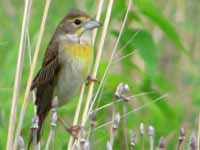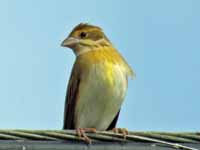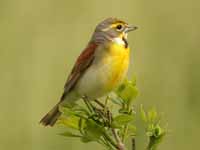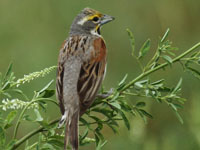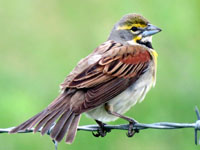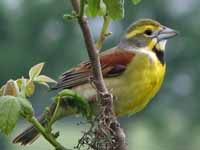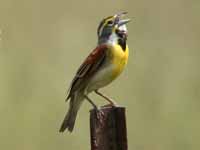THE WORLD BIRDS - An Online Bird Book
CARDINALIDAE
Buntings
Order Passeriformes Family Cardinalidae
CARDINALIDAE
The Cardinalidae are a family of passerine birds found in North and South America. The family is comprised of buntings, cardinals, and grosbeaks. However, each of these categories
of birds have similary named birds in other families. The birds of this family are robust, seed-eating birds with strong bills. The family ranges in size from 12-25 cm. They are typically associated with
open woodland. The sexes are dimorphic - they usuaully have distinctive appearances.
Buntings
Order Passeriformes Family Cardinalidae
Other Buntings are in the Emberizidae family.
Genus Passerina
The Passerina genus is made up of the North American buntings (unrelated to the buntings of the Emberizidae). The blue grosbeak was formerly placed in the monotypic genus Guiraca but was included in the Passerine genus based on a molecular study that confirmed its close relation to the Lazuli bunting. It still maintains its grosbeak common name.
Bunting,_Indigo Passerina cyanea
Description: The breeding male is two-toned and vibrant with an indigo blue head transitioning into turquoise blue on the body, with slate-black flight and tail feathers. During winter, the male is mostly brown, resembling the female.
Range:It breeds in North America from southern Canada to the southern United States and migrates south for the winter, from southern Florida and Mexico to Central America and northern South America.
Habitat: Open woodlands, secondary forest, forest edges, and farmlands. brushy forest edges.
Similar to: Blue Bunting. Indigo Bunting has bicolored bill; Blue Bunting does not.
Similar to: Blue Grosbeak. Blue Grosbeak has double wing bars; Indigo Bunting does not.
Similar to: Lazuli Bunting. Female Indigo Bunting has lighter throat than female Lazuli Bunting. Similarly for nonbreeding males.
Conservation Status: Least concern.
Range:It breeds in North America from southern Canada to the southern United States and migrates south for the winter, from southern Florida and Mexico to Central America and northern South America.
Habitat: Open woodlands, secondary forest, forest edges, and farmlands. brushy forest edges.
Similar to: Blue Bunting. Indigo Bunting has bicolored bill; Blue Bunting does not.
Similar to: Blue Grosbeak. Blue Grosbeak has double wing bars; Indigo Bunting does not.
Similar to: Lazuli Bunting. Female Indigo Bunting has lighter throat than female Lazuli Bunting. Similarly for nonbreeding males.
Conservation Status: Least concern.
1, 2) Female 3, 4, 5, 6) Male
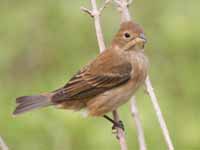
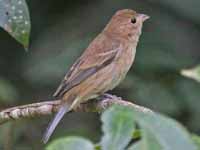
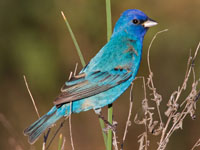

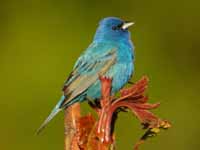
Bunting,_Lazuli Passerina amoena
Description: The male has a blue head and back with two white wing bars and a red breast and white belly. The breeding male is brighter. The female has greyish-brown upperparts with two light wing bars and light-brown underparts.
Range:They breed in the Southwestern United States and migrate south for the winter as far as Mexico.
Habitat: Dry brushy areas near streams, weedy pastures, valleys, thickets, and suburban gardens.
Similar to: Indigo Bunting. Female Indigo Bunting has lighter throat than female Lazuli Bunting. Similarly for nonbreeding males.
Similar to: Varied Bunting. Lazuli Bunting has wing bars; Varied Bunting does not.
Conservation Status: Least concern.
Image by: 1) Maggie Smith 2) Ken_Schneider - California Sean McCann - British Columbia 3) Jerry Oldenettel - New MexicoRange:They breed in the Southwestern United States and migrate south for the winter as far as Mexico.
Habitat: Dry brushy areas near streams, weedy pastures, valleys, thickets, and suburban gardens.
Similar to: Indigo Bunting. Female Indigo Bunting has lighter throat than female Lazuli Bunting. Similarly for nonbreeding males.
Similar to: Varied Bunting. Lazuli Bunting has wing bars; Varied Bunting does not.
Conservation Status: Least concern.
4) Bill Bouton - California 65) Alan Wilson - Deschutes National Forest, Near Fort Rock, Oregon 6) Eugene Beckes
1, 2) Female 3) nonbreeding Male 4, 5, 6) breeding Male
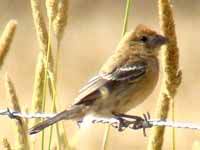
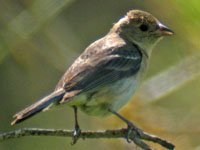
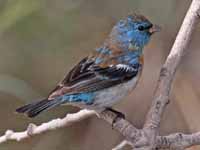
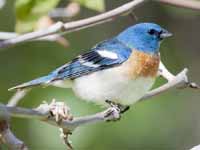
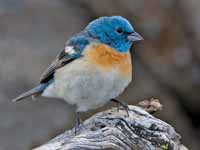
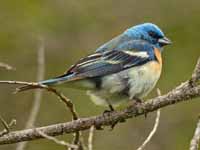
Bunting,_Orange-breasted Passerina leclancherii
Description: The male has turquoise blue upperparts with a green crown and yellow lores, eye-rings, and underparts. The female is grey-green above with yellow underparts.
Range:Endemic to Mexico.
Habitat: Tropical dry forest, scrublands, thickets, brushy woodlands, scrubby clearings, and woodland edges
Conservation Status: Least concern. .
Image by: 1) Jerry Oldenettel 2) mememorice 3) aeDrake09 4) Cornell_Univ's_Neotropical_Birds_Online - Andrew_Spencer Range:Endemic to Mexico.
Habitat: Tropical dry forest, scrublands, thickets, brushy woodlands, scrubby clearings, and woodland edges
Conservation Status: Least concern. .
1) Female 2) nonbreeding male 3 , 4) breeding male
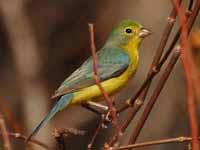
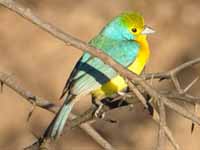
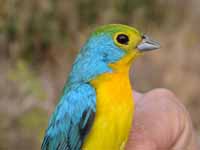
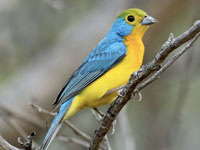
Bunting,_Painted Passerina ciris
Description: It is one of the most beautiful birds in North America. The male has a dark blue head, green back, and red underparts. The female has grey-green upperparts and yellow-green underparts.
Range:They breed in the south-eastern United States and winter in Central America.
Habitat: Thickets, woodland edges, shrublands, and brushy areas.
Similar to: Varied Bunting. Male Painted Bunting much more colorful than male Varied Bunting. Female Painted Bunting is green; female Varied Bunting is brown.
Conservation Status: Least concern.
Image by: 1) Dan_Pancamo 2) Cornell_Univ's_Neotropical_Birds_Online - John_van_Dort Range:They breed in the south-eastern United States and winter in Central America.
Habitat: Thickets, woodland edges, shrublands, and brushy areas.
Similar to: Varied Bunting. Male Painted Bunting much more colorful than male Varied Bunting. Female Painted Bunting is green; female Varied Bunting is brown.
Conservation Status: Least concern.
4) USFWS - Texas 5) Andy_Morffew - Florida 6) Doug Janson 7) Dick Daniels - Brunswick Town, North Carolina
1, 2) Female or juvenile male 3 - 6) Male


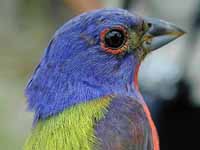

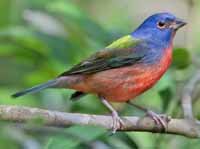
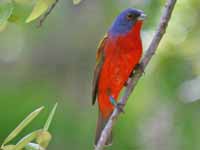
Bunting,_Rose-bellied Passerina rositae
Description: The male is a colorful bird with a royal blue head and upperparts and a characteristic pink breast and orange-yellow belly. The female is greyish above and buff-brown below.
Range:The Rose-bellied Bunting is endemic to a tiny stretch between Oaxaca and Chiapas in Southern Mexico.
Habitat: Arid to semi-arid thorny forests and woodlands.
Conservation Status: Near-threatened
Image by: 1) Cornell_Univ's_Neotropical_Birds_Online - Luke Seitz 2, 3, 4) Nick Athanas 5, 6) Dominic Sherony - Oaxaca, MX 7) Francesco_Veronesi Range:The Rose-bellied Bunting is endemic to a tiny stretch between Oaxaca and Chiapas in Southern Mexico.
Habitat: Arid to semi-arid thorny forests and woodlands.
Conservation Status: Near-threatened
1, 2) Female 3) Juvenile male 4, 5, 6) Male

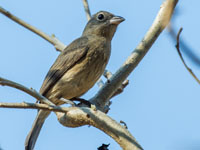
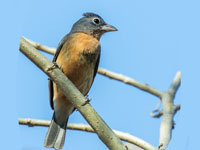
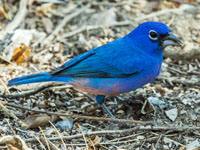

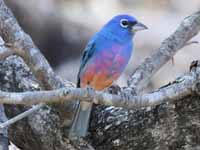
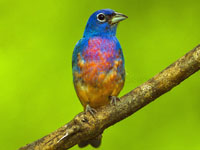
|
Bunting,_Varied Passerina versicolor
Description: The male has a dark purple body, reddish nape, and blue forehead. Females are uniformly brown.
Range:From Southwest United States to Guatemala.
Habitat: Deserts, shrublands, thorny brush thickets, thorn forests, and woodlands.
Similar to: Crimson-collared Grosbeak. Male Crimson-collared Grosbeak as a black head; male Varied Bunting have a blue forehead.
Similar to: Painted Bunting. Male Painted Bunting much more colorful than male Varied Bunting. Female Painted Bunting is green; female Varied Bunting is brown.
Similar to: Lazuli Bunting. Lazuli Bunting has wing bars; Varied Bunting does not.
Conservation Status: Least concern.
Image by: 1, 5) Len Blumin - Mexico 2) mememorice 3) Jerry Oldenettel - Guadalupe Canyon, Hidalgo Co., NM Range:From Southwest United States to Guatemala.
Habitat: Deserts, shrublands, thorny brush thickets, thorn forests, and woodlands.
Similar to: Crimson-collared Grosbeak. Male Crimson-collared Grosbeak as a black head; male Varied Bunting have a blue forehead.
Similar to: Painted Bunting. Male Painted Bunting much more colorful than male Varied Bunting. Female Painted Bunting is green; female Varied Bunting is brown.
Similar to: Lazuli Bunting. Lazuli Bunting has wing bars; Varied Bunting does not.
Conservation Status: Least concern.
4) Louis Agassiz Fuertes 6) Dominic Sherony - Guatemala
1, 2, 3) Female 4, 5, 6) Male
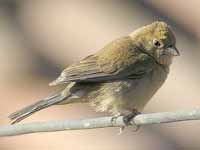
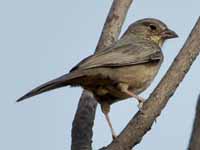
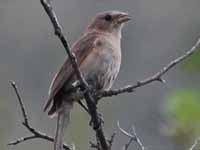
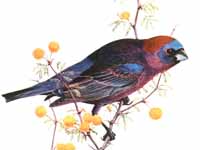
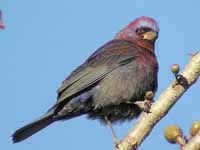
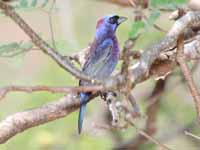
Grosbeak, Blue Passerina caerulea formerly Guiraca caerulea
Description: The male is a rich royal blue with chestnut wing bars. It has a small black stripe between the eyes and bill. The female is grey-brown above with tan wing bars and pale brown below with a blue-tinged rump.
Range:Native to Mexico and the southern United States, and migrates south, spending winters in Central America and northern South America.
Habitat: Semi-open wooded habitats, riparian woodlands and woodland edges, scrubland, thickets, cultivated lands, and open fields.
Similar to: Blue Bunting. Blue Grosbeak has double wing bars; Blue Bunting does not.
Similar to: Indigo Bunting. Blue Grosbeak has double wing bars; Indigo Bunting does not.
Conservation Status: Least concern.
Image by: 1) Bill Lynch - New Jersey 2, 3, 4) Dick Daniels -
North CarolinaRange:Native to Mexico and the southern United States, and migrates south, spending winters in Central America and northern South America.
Habitat: Semi-open wooded habitats, riparian woodlands and woodland edges, scrubland, thickets, cultivated lands, and open fields.
Similar to: Blue Bunting. Blue Grosbeak has double wing bars; Blue Bunting does not.
Similar to: Indigo Bunting. Blue Grosbeak has double wing bars; Indigo Bunting does not.
Conservation Status: Least concern.
5) Maggie Smith - California 6)Jerry Oldenettel - New Mexico
1, 2, 3) Female 4, 5, 6) Male

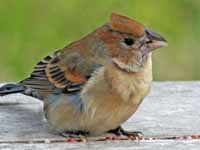
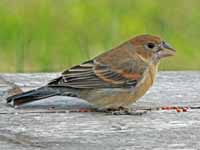
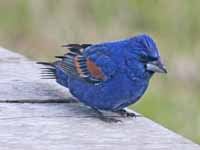

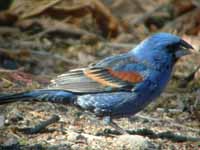
The following species are in family Cardinalidae , but quite distinct from the buntings.
Genus Amaurospiza
Seedeater,_Blue Amaurospiza concolor
Description: Males have a deep blue-black plumage, and females are cinnamon-brown with slightly darker upper-wings and upper-tail.
Range:Southern Mexico, Central America, and northern South America.
Habitat: High-lying woodlands and bamboo forests.
Conservation Status: Least concern.
Image by: 1) Cornell_Univ's_Neotropical_Birds_Online - John_Cahill in Guatemala 2) Nick Athanas - EcuadorRange:Southern Mexico, Central America, and northern South America.
Habitat: High-lying woodlands and bamboo forests.
Conservation Status: Least concern.
1) Female 2, 3) Male
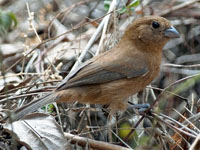

Genus Granatellus
The Granatellus genus was previously placed in the Parulidae family but was moved to the Cardinalidae following biochemical analysis. There are three species of chats in this genus characterized by the distinctive black, white, and red plumage of the males.
Chat,_Gray-throated Granatellus sallaei
Description: The male is dark grey above with a grey head and throat and white brow. It has bright red underparts. The female is lighter grey above with a buff brow and breast and a white belly.
Range:Belize, Guatemala, and Mexico.
Habitat: Tropical and subtropical dry lowland forests.
Conservation Status: Least concern.
Image by:
1) Jorge Montejo - Mexico 2, 4) Amy McAndrews - Mexico 3) Cornell_Univ's_Neotropical_Birds_Online - Luke_SeitzRange:Belize, Guatemala, and Mexico.
Habitat: Tropical and subtropical dry lowland forests.
Conservation Status: Least concern.
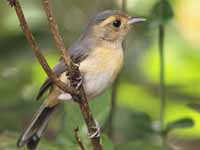
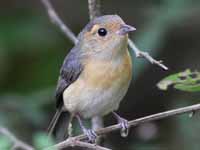
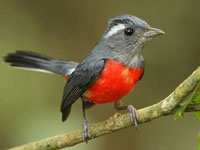
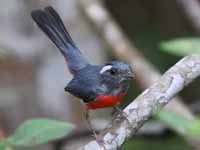
Chat,_Red-breasted Granatellus venustus
Description: The male has black upperparts and a black head with white brows, a white throat, and red breast and belly with broad white flanks. The female is greyish-brown and pale below with a faint pink breast and white brows.
Range: Endemic to the western edge of Mexico and adjacent parts of Guatemala.
Habitat: Tropical and subtropical dry, thorny forests.
Conservation Status: Least concern.
Image by: 1) Jerry Oldenettel 2) Cornell_Univ's_Neotropical_Birds_Online - Suzanne_Labbe 3) Francesco_Veronesi 4) Nick Athanas 5) Ron Knight Range: Endemic to the western edge of Mexico and adjacent parts of Guatemala.
Habitat: Tropical and subtropical dry, thorny forests.
Conservation Status: Least concern.
1, 2) Female 3 - 5) Male
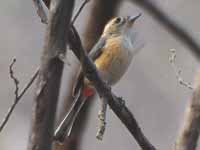
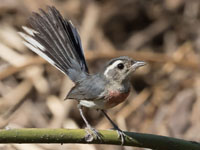
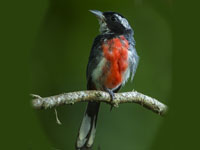
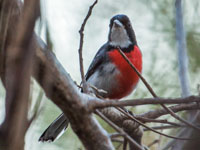

Chat,_Rose-breasted Granatellus pelzelni
Description: Nearly identical to the red-breasted chat with less white on its flanks. The female has grey upperparts, a white belly, and a buffy face, chest, and under-tail.
Range:Found throughout north-eastern South America.
Habitat: Tropical and subtropical moist lowland forests
Conservation Status: Least concern.
Image by:
1) Claudio Timm 2) Cornell_Univ's_Neotropical_Birds_Online - Eduardo Patrial.Range:Found throughout north-eastern South America.
Habitat: Tropical and subtropical moist lowland forests
Conservation Status: Least concern.
1, 2) Male

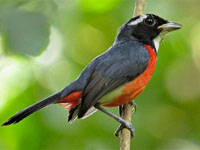
Genus Spiza - 1 species
Dickcissel Spiza americana
Description: The dickcissel has a grey head with a yellow supercilium and a grey bill. Its body plumage is brownish above with black stripes. It has rust-colored shoulders and a yellow breast, with a pale greyish-white belly and rump. The male has a black throat patch. Females are duller than males.
Range:It is native to the mid-western United States and migrates south for the winter from southern Mexico to northern South America.
Habitat: Grasslands, prairies, meadows, and croplands.
Similar to: Eastern Meadowlark. Meadowlark long pointed bill; Dickcissel has short wedge shaped bill. Meadowlark larger.
Conservation Status: Least concern.
Image by: 1) Tiwago - Illinois 2) Maggie Smith - California 3) T Lindenbaum - Illinois 4) Ramendan 5) Tony_Castro - Illinois 6) Nick_Varvel - Kansas 7) RebelAt - Missouri 8) Patti McNeal Range:It is native to the mid-western United States and migrates south for the winter from southern Mexico to northern South America.
Habitat: Grasslands, prairies, meadows, and croplands.
Similar to: Eastern Meadowlark. Meadowlark long pointed bill; Dickcissel has short wedge shaped bill. Meadowlark larger.
Conservation Status: Least concern.
1, 2) Female or 1st year male 3 - 5) nonbreeding Male 7, 8) Breeding male
